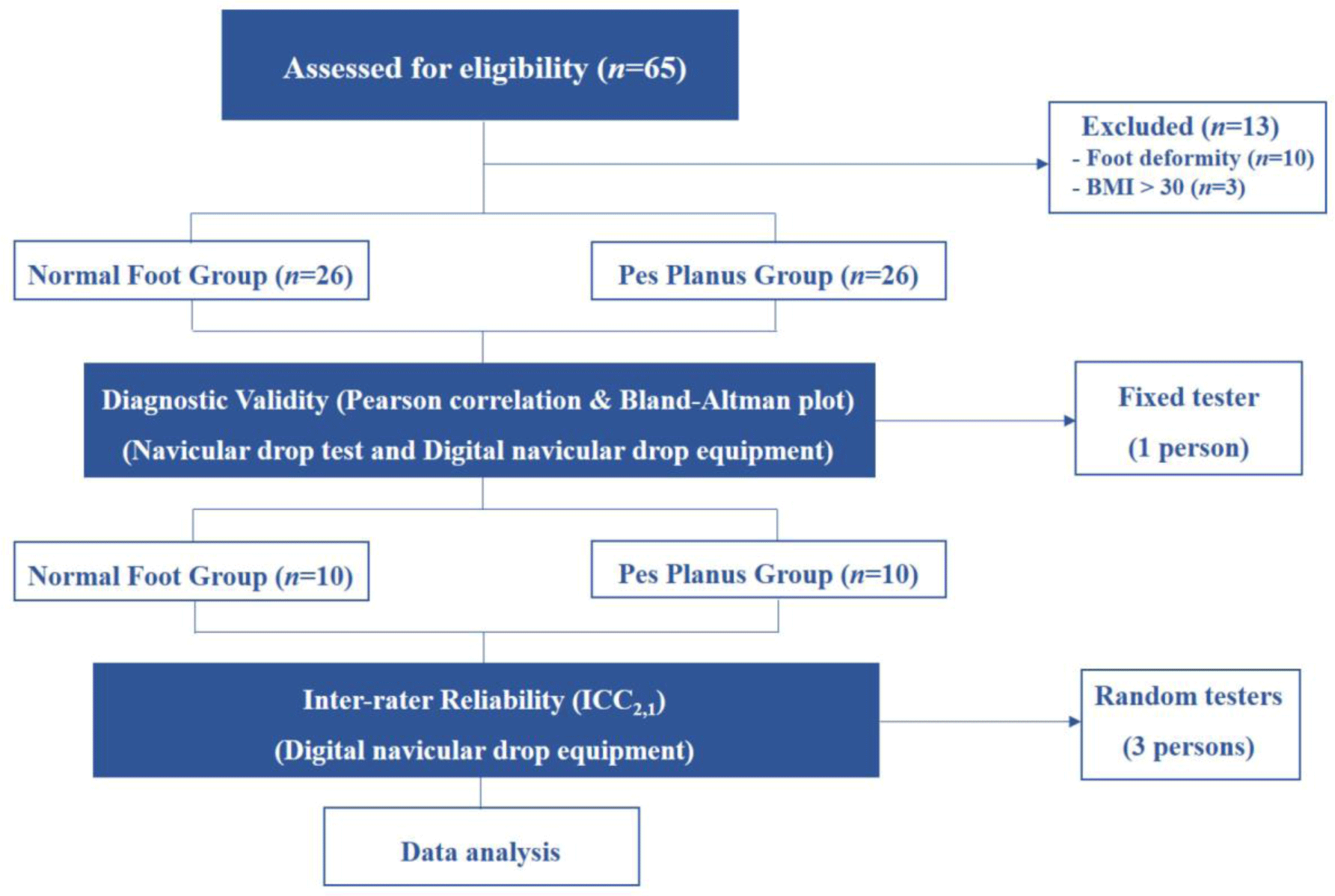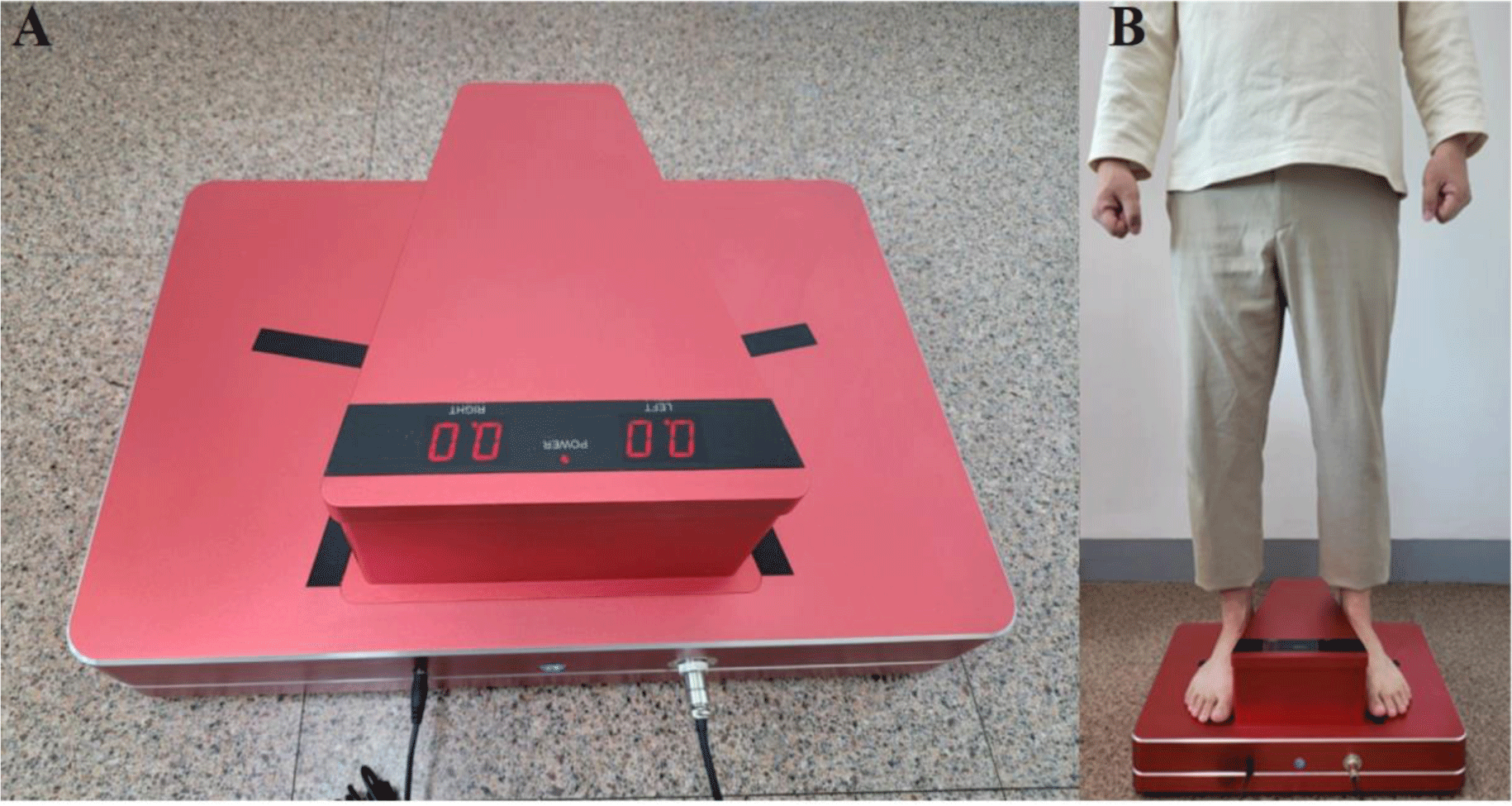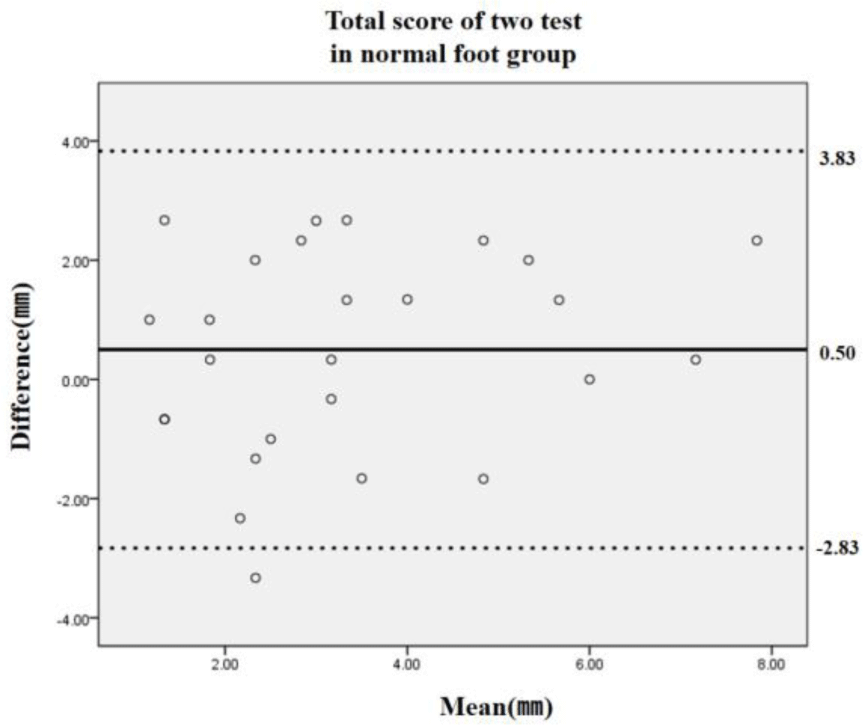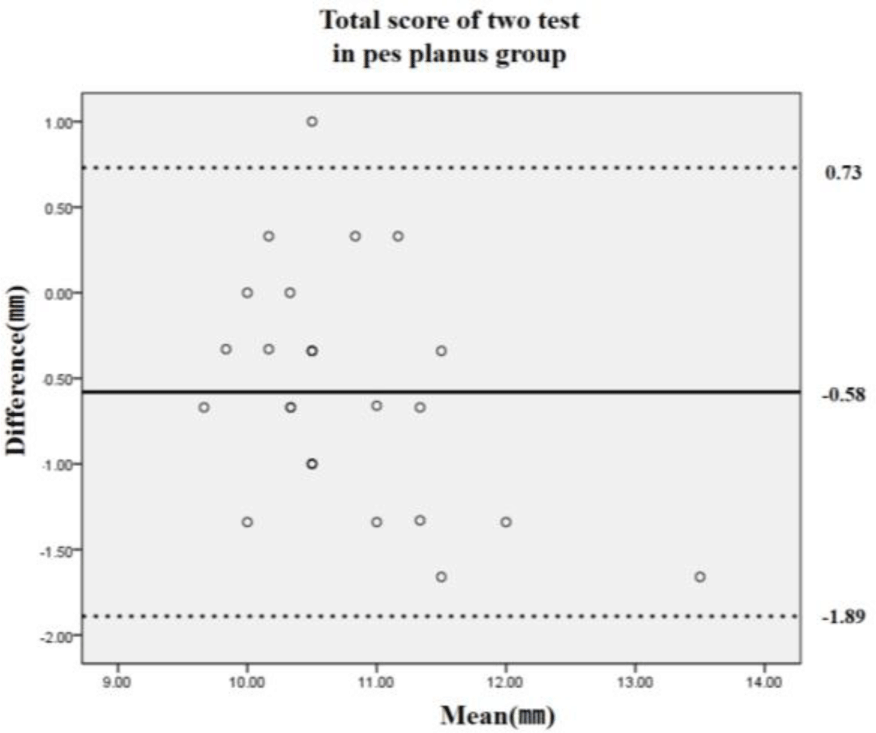INTRODUCTION
Developing children have soft bones, lax ligaments, increased adipose tissue, and immature neuromuscular control.1,2 Consequently, “flat” arches are normal for children up to 8 years of age.3 Although various ligaments prevent a decrease in the medial longitudinal arch (MLA) height, such as the plantar fascia and spring ligament,4 weakness of the foot intrinsic muscles is also essential.5 Adults with a flexible pes planus experience more back and lower extremity pain6 and reduced quality of life.7 In America, around 5 million people are diagnosed with pes planus8 and >40% of young adults are at risk of the condition.9 In Germany, 8% of pes planus patients are prescribed foot orthotics, and the related costs reached 466.6 million Euros in 2019.8,10 A flexible pes planus cannot maintain normal inversion in the terminal stance phase, resulting in potential foot and lower extremity fatigue.11 Evaluation of pes planus is important for avoiding flexible pes planus.
Lateral weight-bearing X-rays are commonly used to assess pes planus, as well as to measure Meary’s talo-first metatarsal angle, the angle of plantar flexion of the talus, also called the talo-horizontal angle, and the talocalcaneal angle.11 These examinations have some restrictions due to radiation exposure, low accessibility, and high costs.12 Clinical tests such as the navicular drop test (NDT) and arch height index are commonly used in clinical practice because they are convenient, cost-effective, feasible, readily available, and non-invasive, and do not require specific devices.12
For this reason, NDT is continuously used to identify the intervention effects related to pes planus, from past study24 to recent study.25 Although the NDT is a widely used clinical test, its intra- and inter-rater reliability is controversial. The intra-rater reliability reportedly ranged from 0.33 to 0.76 and was slightly higher than the inter-rater reliability.13 Evans reported that while the intra-rater reliability of the NDT ranged from 0.51 to 0.77, the inter-rater reliability was low, at only 0.46.14 A manual clinical test may lead to errors due to a lack of training.15
In addition, placing the body weight unequally on each foot can cause measurement error. Participants should widen their stance more than usual. The criterion for the neutral position of the subtalar joint differs among examiners, and there is a difficulty in accurately positioning it. To solve these problems, Park and Park developed digital navicular drop test equipment (D-NDT), which was shown to have diagnostic validity and reliability for participants with normal feet.16 However, their data were insufficient for generalization to all people. Therefore, this study investigated the diagnostic validity and inter-rater reliability of D-NDT in people with and without pes planus.
METHODS
The sample size was determined using the G-Power program (3.1.9.6, Düsseldorf University, Germany) based on the correlation between NDT and D- NDT grades. In a pilot study, the correlation coefficient of the total NDT and D- NDT grades was ≥0.5. Therefore, we needed to enroll 46 people assuming a correlation of 0.50, with a power of 0.95 and significance level of 0.05. Considering the potential for dropouts, 3 participants were added to each group, such that there were 26 people with normal feet and 26 with pes planus (Figure 1). The participants had no foot deformities or diseases, and no foot pain or neurological disorders. Pes planus was defined as ≥10 mm in the NDT,17,18 the MLA angle of >131 degrees,19 and the body mass index (BMI) <30.18 The dominant foot, as determined by kicking a ball, was recorded in all participants.18 The entire study procedure was approved by the University Institutional Review Board. Table 1 summarizes the general characteristics of the two groups.

The NDT was performed to assess the diagnostic validity of the NDT and D- NDT.16 Participants removed their shoes and were barefoot. The navicular tuberosity was marked with a pen. Then, the participants maintained the subtalar joint in a neutral position while seated in a non-weight-bearing posture, and the distance between the navicular tuberosity and the ground was measured using ruler (Stainless hardened 300 mm, Minemura, Janpan). All assessments were repeated three times in each posture.
After learning how to use the D-NDT,16 reflective markers were attached to the navicular tuberosities of all participants. Subsequently, they were instructed to place their bare foot on a reflector sensor along a guide line and relax the foot. In a sitting position, the examiner relaxes the subject’s foot and then places it comfortably in the sensor area. Next, the distance between the navicular tuberosity and the ground was measured while both seated and standing (Figure 2). The examiners were experts with sufficient knowledge of the NDT and D-NDT. All assessments were repeated three times in each position.

The medial longitudinal arch angle between the line from the medial malleolus to the navicular tuberosity and the line connecting the head of the first metatarsal bone and the navicular tuberosity was measured in degrees.19
The inter-rater reliability of the D-NDT was assessed based on the grades of three raters: a physical therapy senior student, a physical therapist with <10 years of clinical experience, and a physical therapist with >10 years of clinical experience. All raters participated in the experiment after receiving >30 minutes of training on use of the D-NDT.
Independent t-tests were used to compare general characteristics between two groups. The diagnostic validity of the NDT and D-NDT was determined using Pearson’s correlation coefficient and Bland–Altman plots. The inter-rater reliability of the D-NDT was assessed using an intraclass correlation coefficient (ICC). For the statistical analyses, SPSS for Windows (ver. 18.0; SPSS Inc., Chicago, IL, USA) was used, and the level of statistical significance was set to 0.05.
RESULTS
Regarding the diagnostic validity of the two tests (Table 2), in the normal foot group, the correlation between the NDT and D-NDT was excellent in the sitting (r=0.938, p<0.001) and standing (r=0.926, p<0.001) positions. The correlation between the results of the two tests was significant in the normal foot group (r=0.650, p<0.01). In the pes planus group, the correlation between the NDT and D-NDT grades was excellent in the sitting (r=0.980, p<0.01) and standing (r=0.977, p<0.01) positions. The correlation between the results of the two tests was significant in the pes planus group r=0.740, p<0.01).
The mean difference between the two tests was 0.50 (95% limits of agreement: –2.83 to 3.83) mm in the normal foot group (Figure 3) and –0.58 (95% limits of agreement: –1.89 to 0.73) mm in the pes planus group (Figure 4).


Examining the inter-rater reliability of the D-NDT (Table 3), the ICC of the normal and pes planus groups was 0.94 and 0.958, respectively, in the sitting position, and 0.978 and 0.957, respectively, in the standing position, with all values indicating excellent reliability. The total grade had an ICC of 0.702 in the normal foot group, demonstrating good reliability, and 0.773 in the pes planus group, reflecting excellent reliability.
DISCUSSION
The NDT is a reliable tool for measuring foot pronation and has an excellent correlation with the foot posture index (r=0.8), another tool for measuring foot pronation.17 Consequently, the NDT is mainly used to clarify the intervention effect for people with pes planus.18 The D-NDT was developed to enhance the precision of the NDT, which is clinically valuable, and to clarify the diagnostic validity of the NDT and D-NDT.
In this study, there were excellent correlations between the NDT and D-NDT grades in both the sitting (0.938–0.980) and standing (0.926–0.977) positions. On subtracting the height of the plantar arch in the standing position from that in the sitting position, the total grades had correlations between 0.650 and 0.740. The correlation was higher in the normal foot group than the pes planus group, reflecting the clinical value of the NDT. Furthermore, the Bland–Altman plot showed that all except one case in both groups were within the 95% limits of agreement.
The reported reliability of the NDT varies widely. An ICC value <0.4 is poor, 0.4–0.6 is fair, 0.6–0.75 is good, and >0.75 is excellent.23 In a previous study, the intra-rater and inter-rater reliability were fair.13,22 In a recent study, the intra- and inter-rater reliability were >0.9, which is excellent.17 However, another study reported low (0.46) inter-rater reliability of the NDT.14 Despite its strengths, quantitative measurement of the MLA still has poor reliability20 and varies depending on the user’s experience.21 The D-NDT was developed with ease of use and reliability in mind. In a study of normal subjects, the intra-rater reliability of the D-NDT was excellent, ranging between 0.93 and 0.95 depending on the posture.16 In this study, the normal group showed reliability values of between 0.616 and 0.978 depending on posture, while the pes planus group had very high reliability values (>0.96) in all postures. In addition, the total grades in the pes planus group had good correlations (>0.75).
The NDT poses a challenge, in that the experimenter needs to shift the legs forward, backward, left, and right to distribute the body weight equally on both feet. With the D-NDT, both feet naturally bear equal weight, increasing measurement accuracy. In particular, this equipment does not require ability to align the neutral position of subtalar joint in a sitting position. This is an equipment that anyone can easily check their pes planus. If the angle of the MLA is then added to the height of the arch, its clinical value increases.







